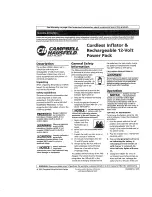
1
15
14
model no. 058-9372-4 | contact us 1-888-670-6682
3. Place and lock the socket (1) over the
square drive (2) of the tool (Fig. C).
• Use only the sockets that are specifically designed for
this Air-powered Ratchet. Failure to comply may result
in injury or damage to the tool.
CAUTION!
Potential hazard that may result in injury or damage to
equipment.
2. Rotate the forward/reverse switch
clockwise towards “F” for tightening
operation, and counter-clockwise
towards “R” for loosening operation
(Fig. B).
4. Place the socket on the nut to be
removed or installed, and press the
trigger (1) to operate the tool (Fig. D).
1. Plug in compressor, turn it on, set the
pressure regulator to 90 PSI, attach one
end of the air hose to the compressor
and the other end of the air hose (1) to
the tool (2) (Fig. A).
OPERATION
DANGER!
Potential hazard that will result in serious injury or
loss of life.
• Keep children away from the work area. Do not allow
children or untrained persons to handle power tools.
Failure to comply will result in serious injury or loss of
life.
WARNING!
Potential hazard that could result in serious injury or
loss of life.
• Do not allow the tool to free run for extended periods
of time as this will shorten its life.
• Ensure the air supply is clean and has a regulated
pressure of 90 PSI.
• Do not use additional and excessive force on the tool
to remove a nut. Failure to comply could lead to
serious injury or loss of life.
2
1
Preparation before use
1. Attach the air hose to the air inlet plug of the Air-powered Ratchet.
Note: Add a few drops of pneumatic tool oil to the air inlet plug before
operation, if the automatic oiler system is not used. Add a few
drops more after each hour of continuous use.
2. Set the compressor air pressure to 90 PSI. Do not exceed the
recommended air pressure (see “Technical specifications” secti
on).
3. Check the air connection for leaks. Now the tool is ready for use.
Note: Turn off the air compressor and disconnect the air hose before
you change a socket. After you attach the socket, connect the
air hose and turn the air compressor back on.
1
2
Fig. A
Fig. C
Fig. D
Fig. B
TM































